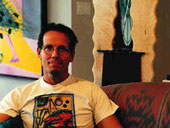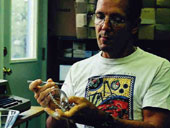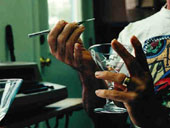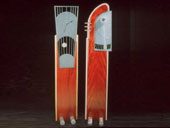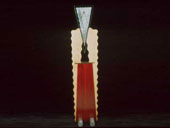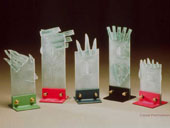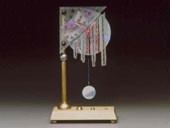Learning Library Segments
Robert McCandless
Primary Use of Medium: Sandblasting GlassInterviewer: Donna Wetegrove
Interview Location This interview takes place with Robert McCandless in his studio as he incorporates the resist of a new design on martini glasses for his next show .
Interview Date: 8.22.02
Writer: Stephanie Morgan
Inspiration
Art Form/Product
Green Aspects
Marketing Values
Special Offering
Artist Profile
Inspiration
"There are angels all around us. We need to listen to them. They come from different places."What Type Of Artist Do You See Yourself As?
" functional, production, a mixed media artist"
How Did You Get Here?
Robert McCandless found his way to his craft forms from visually inspirational books by Antonio Gaudi & Knoll Furniture. At an early age, he was used to working with his hands by rebuilding old cars and building models. He recalls his teachers and family commenting, or rather predicting, that he was going to make a living with his hand.
At a time when Robert had no direction in his life, and having just gotten out of the Army, he took a test through the Veterans Administration to see what he was most suited for on the GI Bill. This Army shipping clerk was told he should be an artist or a photographer. All his life, however, he had been told being an artist was a useless profession; serves no purpose and you can't make a living at it. And yet, he always remembers drawing as a means of purging his emotions something he just did.
He also remembers a "styrofoam/trash-thing" project when he was asked to make something that represented something else out of trashmore specifically, from the bank trash where he worked at that time. He came up with what he calls the "Super Ninety Minute Representation of the Super Heterodyne Receiver" or "What Ever Happened to Monster Heterodyne" mind you this was when tube radios were popular, he comments.
As a hobby, Robert first started out making lamps; however, they were expensive to make. Then the architectural industry, which was his target market, started to weaken in Austin at that time. Instead of quitting, and at the prodding of a "builder friend", Roberts' career took a turn. His friend encouraged him to make some other things and actually scheduled an appointment for Robert with a gallery to represent him. It all started to sell and "the rest is history!" Robert is quick to say, "There are angels all around us. We need to listen to them. They come from many different places."
Where Does Your Inspiration Come From?
"Inspiration can come from anywhere". Robert gets his ideas for designs by creatively reinterpreting what he sees around him. More specifically, he subscribes to specific magazines like Architectural Record, Crafts Report and Lighting Industry News to "look at the pictures". "I never read a word in them." Once a month you can find Robert at bookstores going through all the periodicals to keep current with trends and to see if there are others he wants to subscribe to. If so, he will subscribe for one year.
Art Form/Product
"Don't' let what you see done in this medium restrict you."How Would You Describe Your Work?
Robert's work is functional: tablesettings, wine glasses, all affordable and individual because all patterns are applied by hand. His clocks tell time and are highly sculptural. The glassware is Robert's "bread & butter, his foundation income" to his career and where he started. One of a kind pieces equal more thought and more time. The "bread & butter" now allows him to undertake any project he wants to do at any time because he can afford to and that equals a "successful artist" to him!
Why Do You Like The Medium?
"I have very little patience and glass doesn't require patience it moves very fast. My models never were quite as meticulous as my friends as a kid. I like details but have to have a product within an outcome." He lives by the words of a former art teacher who reminded him that it is much easier to overwork a painting than under-work it he comments that he could never work on a painting for a year.
Does The Material Dictate The Design Or Does Your Design Idea Dictate How The Material Is Used?
Robert comments that materials dictate to him even though he always thought he wanted to dictate to it to draw it. As he now knows more, it has become a dance "and we step on each others' toes every now and then." He says he literally speaks to the boards at Paxton (a wood supplier store in Austin).
What Tools Are Required In Your Process?
In sandblasting, a compressor and a sandblaster (pressure blaster and cabinet to contain the dust). For larger architectural pieces, a walk-in cabinet is required with a protective suit and fresh air helmet. Drills and diamond bits allow Robert to customize and embellish his pieces.
Connections are varied depending on the outcome Robert wants to achieve. His most commonly used options include glue or decorative mechanical cold connections done with, of all things, lamp parts which, as Robert will tell you, is a whole other world in itself. He now even has some of his cold connections cast specifically for his designs.
Another very important tool Robert utilizes is his computer. In fact, it is where his pattern designs start before the sandblasting process can occur. He uses his computer in a way the sign industry never thought of! Graphic software allows him to draw his patterns in the computer where he can manipulate and customize the size to fit the glassware it will eventually be attached to. He can then "print" the pattern onto his resist that is comparable to an industrial strength contact paper (adhesive on one side). His printer is fitted with a fine blade that actually cuts out the pattern being "printed". His software allows him to maximize the full spread of the resist sheet by filling it completely with his patterns to minimize waste. Robert concurs that utilizing his computer in this way was truly the turning point in the "bread and butter" aspect of his business. The tedious and hand numbing aspect of hand cutting all his patterns was no longer an issue and production possibilities now soared. Though it was a big decision to incur the expense of this computer system, one he had to take out a loan for, it has proven to be the best decision for his business that he ever made. It also represents one of the aspects of his own ingenuity in adapting equipment that was designed for one use and is completely applicable to another. Robert commented several times how the suppliers and sales representatives could not believe what he was trying to do. His willingness to pursue it really paid off for him.
Please Summarize Your Entire Process.
"It begins with a thought" something that is not force-fed. "Once you start sanding, scraping, drilling holes and hammering, like when brush touches canvas; then the process really begins. It doesn't happen when you are sitting still."
After the thought, for Robert, it begins with his pattern search and moves to his sketchbook. He considers the size of every piece of stock glass from his suppliers. Then it moves to the computer-generated patterns on advertising film that he uses as resist. The resist is then hand applied to the glass, hand blasted by Robert, then cleaned. Next step is a photo shoot of the finished pieces. Robert himself then incorporates the photos into computer generated catalog pages. Then it is off to a show where orders are taken from galleries and other wholesalers.
"This is not a 9:00 5:00 job. Sometimes it is 9:00 3:00 three days a week while other times it is 8:00 10:00 six days a week." Robert is avid about taking Sundays off to rest and rejuvenate. The workload and time necessary varies and it takes discipline to make it happen, especially in the beginning. "It can turn you into a workaholic." Robert encourages you to control it with refocus, which he has had to do himself. He points out that it is hard to separate, especially if there is fear of economic instability. For him, this is a commitment with no regrets. He likes being able to depend on himself. "There is nothing I can't do once I puts my mind to it!"
Do You Recommend What You Do As A Career Choice? Why?
"Oh yes! I make more money than I ever thought I would make and there is potential to make more. It is as viable as acting or as medical school." Even more important, it is his choice.
What Tips Might You Have For Someone New To The Medium? How Best To Develop Their Interest?
"Don't let what you see done in this medium restrict you. Sometimes you copy in the beginning to learn the skill. Don't be afraid to paint glass, for example. It is a lost art. Find a mentor." Most mentors who are mentoring don't know it, Robert points out. "They are those angels. Most mentors have an idea of their own and see in you an interest and can help you strive for it. A mentor is not always gentle though. They may show you what you don't want to be like. A mentor is one who chooses to have you be your best. However, the only person who can change your life is you. All the mentors in the world cannot change that."
Robert encourages you to take responsibility for yourself to make your project make your art happen. Act on all your ideas. Dream. Then act some more. "Completion is important but don't rush it. If necessary, set it aside till the details fall into place."
Green Aspects
Please Point Out Any "Green" Aspects Of Your Process And Your Medium.Much of the materials Robert uses can be recycled to some degree. However, the silica utilized in the actual sandblasting process can only be reused so long till it becomes dust. It is non-toxic as it goes air-borne as dust. Aluminum oxide, Robert points out, is better for you than sand from a river bottom that can produce free silica that can cause black lung disease. However, that does not mean aluminum oxide is completely safe. Caution in handling and breathing is always recommended.
Spray paints Robert sometimes uses to highlight his pieces are now labeled ozone safe by the manufacturer.
It is easy for Robert to recycle parts when he is letting the parts dictate the limits of his designs. Otherwise, he lets employees take home and make what they want with parts that are not applicable to the business. Another way Robert minimizes waste is by having many of his parts machined by an aluminum expert so he gets exactly what he needs which saves him time and additional waste.
If any glass, metal or paper remain unusable, Robert points out that it lands in containers that are in support of the City of Austin's recycling program and not in our landfill. "It all matters!"
Marketing Values
"I believe all depression is tied to a lack of a creative outlet."Please Talk About Making Multiples Of A Creative Effort As A Part Of Your Business.
"You get bored." Robert is quick to say that it is important to put some changeability into it to give yourself some personal interest. He had to hire people to help him. Robert did the first $10,000.00 of his business on his own, cutting all patterns by hand. He had to learn to let go after he properly trained people and even now has people who can help him with visual inspection of the final product. He learned to trust; he became an employer an orchestrator.
Robert loves to get dirty, so he has to manage not only being an employer. As he has good, trained people around him, he can stay with his creative endeavors. If he couldn't be creative, he would be depressed, he says. "I believe all depression is tied to a lack of a creative outlet."
Robert strongly recommends surrounding yourself with people who give you positive feedback. Choose your close friends.
Where Do You See Your Creativity Evolving?
Robert is clear that he will go back to where he started drawing. Going back to sketching and perhaps adding watercolor and underwater photography to his portfolio are most appealing to him. When he can no longer handle 150 pound pieces of glass, for instance, he intends to still be working only then having others carry on his glasswork.
Special Offering
"Most mentors have an idea of their own and see in you an interest and can help you strive for it."An opportunity to bring creativity with glass into the classroom! Robert McCandless has dealt with special education kids in classroom workshop situations. He has also been involved with one week-long creative retreats.
Robert would like to make his talents available to Austin Area schools in the following two ways:
- Willing to do 2 3 day workshops where students can actually create a project by the end of the workshop.
- Visit a shop class situation where he would work through a project with the entire class from conception and actually do the work himself to show them the process and how problems are solved along the way.
Visit Robert at his web site, www.mccandlessdesigninc.com
Artist Profile:
Robert McCandless9900 Honeycomb Dr.
Austin, Texas 78737
512/288-4440
512/288-6627 fax
www.mccandlessdesigninc.com
Thank you for utilizing TIPS On Art Learning Segments On The Web to further your understanding of the process of artists and art forms. Please take a few minutes to fill out our website survey. Through your feedback, and by making special requests of us for future segments, we will know how TIPS On Art has impacted your situation.

